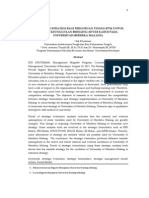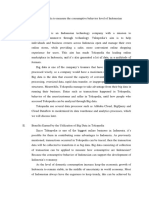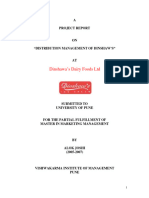0 ratings0% found this document useful (0 votes)
391 viewsBistrat TIROCA Gojek
Bistrat TIROCA Gojek
Uploaded by
Rendy FranataGo-Jek has four competitive advantages over others: patent, brand, product development capability, and product/service innovation. These variables create a strong competitive advantage. The analysis recommends that Go-Jek further increase and develop these strengths to maintain its competitive position in the market.
Copyright:
© All Rights Reserved
Available Formats
Download as PPTX, PDF, TXT or read online from Scribd
Bistrat TIROCA Gojek
Bistrat TIROCA Gojek
Uploaded by
Rendy Franata0 ratings0% found this document useful (0 votes)
391 views4 pagesGo-Jek has four competitive advantages over others: patent, brand, product development capability, and product/service innovation. These variables create a strong competitive advantage. The analysis recommends that Go-Jek further increase and develop these strengths to maintain its competitive position in the market.
Original Description:
VRIN VRIO TIROCA
Copyright
© © All Rights Reserved
Available Formats
PPTX, PDF, TXT or read online from Scribd
Share this document
Did you find this document useful?
Is this content inappropriate?
Go-Jek has four competitive advantages over others: patent, brand, product development capability, and product/service innovation. These variables create a strong competitive advantage. The analysis recommends that Go-Jek further increase and develop these strengths to maintain its competitive position in the market.
Copyright:
© All Rights Reserved
Available Formats
Download as PPTX, PDF, TXT or read online from Scribd
Download as pptx, pdf, or txt
0 ratings0% found this document useful (0 votes)
391 views4 pagesBistrat TIROCA Gojek
Bistrat TIROCA Gojek
Uploaded by
Rendy FranataGo-Jek has four competitive advantages over others: patent, brand, product development capability, and product/service innovation. These variables create a strong competitive advantage. The analysis recommends that Go-Jek further increase and develop these strengths to maintain its competitive position in the market.
Copyright:
© All Rights Reserved
Available Formats
Download as PPTX, PDF, TXT or read online from Scribd
Download as pptx, pdf, or txt
You are on page 1of 4
Wahyu Fahrul Ridho 29116013
Abdul Rasyid Romadhani 29116028
Langgeng Setyono 29116009
M. Balya Malkan F. 29116208
TIROCA AND VRIN ANALYSIS OF GO-JEK
INDONESIA
Based on the analysis, there are 4 variables that
have competitive advantage over others.
Patent
Brand
Product Development Capability
Product and service innovation
Those variables creates strong competitive
advantage among others.
It doesnt necessarily to be one process, but it also
integratingly
CONCLUSION
Gojek should increase its strength
and develop it further to gain
competitive advantage and
sustain its position in the market
You might also like
- Macpherson Refrigeration LimitedDocument14 pagesMacpherson Refrigeration LimitedRendy Franata100% (1)
- CASE STUDY ANALYSIS REPORT Eng FinalDocument26 pagesCASE STUDY ANALYSIS REPORT Eng FinalFaishal Dzaky AffiantoNo ratings yet
- Assessment 1 (Semester 1) (Marketing)Document11 pagesAssessment 1 (Semester 1) (Marketing)Yesith Yasarathna50% (2)
- Bukalapak Market AnalysisDocument4 pagesBukalapak Market AnalysisHari Camel IINo ratings yet
- Questions 137Document1 pageQuestions 137Taranpreet VermaNo ratings yet
- Chaos at Uber - The New CEO's ChallengeDocument13 pagesChaos at Uber - The New CEO's ChallengeIsabella SydneyNo ratings yet
- Tugas Personal Ke-1 Week 2/ Sesi 3Document18 pagesTugas Personal Ke-1 Week 2/ Sesi 3jony leiteNo ratings yet
- Development of Modern Solid Propellants: Introduction: Chemical Propellants, Solids and LiquidsDocument21 pagesDevelopment of Modern Solid Propellants: Introduction: Chemical Propellants, Solids and LiquidsAditya PathakNo ratings yet
- Go JekDocument10 pagesGo JekSandro Fernando SethieawanNo ratings yet
- The-Business-Model-Canvas IKEADocument1 pageThe-Business-Model-Canvas IKEAPasukan EliteNo ratings yet
- Chapter 18 Business Expansion PowerpointDocument16 pagesChapter 18 Business Expansion Powerpointapi-384311544No ratings yet
- Presented To: - DR Omnia Mokhtar: ContentDocument12 pagesPresented To: - DR Omnia Mokhtar: ContentAhmed El SakaNo ratings yet
- Tugas 3-Kelompok 7-IKEA Competitive AdvantagesDocument11 pagesTugas 3-Kelompok 7-IKEA Competitive Advantagesvita colinsNo ratings yet
- NIKES BCG MATRIX Vu Quang TruongDocument4 pagesNIKES BCG MATRIX Vu Quang TruongThông Vũ MinhNo ratings yet
- Sustainable Supply Chain ManagementDocument2 pagesSustainable Supply Chain ManagementMaryam AsdNo ratings yet
- General Business Environment Bibliography Dwitya MM uGMDocument2 pagesGeneral Business Environment Bibliography Dwitya MM uGMDwitya Aribawa100% (1)
- Resume Leadership Communication in An Organizational ContextDocument6 pagesResume Leadership Communication in An Organizational ContextReyhan WNo ratings yet
- Use Joint Venture To Ease The Pain of RestructuringDocument17 pagesUse Joint Venture To Ease The Pain of RestructuringKunal KaushalNo ratings yet
- Garudafood GroupDocument26 pagesGarudafood GroupDiarany SucahyatiNo ratings yet
- FastTrack IT Integration For Sallie Mae Merger Final 1Document23 pagesFastTrack IT Integration For Sallie Mae Merger Final 1Dicky Witama SuryadiredjaNo ratings yet
- Claim Form Cargo InsuranceDocument2 pagesClaim Form Cargo Insurancejatin tyagiNo ratings yet
- A Study On Innovative Practices by Reliance Jio BIRJESHDocument32 pagesA Study On Innovative Practices by Reliance Jio BIRJESHManza DeshmukhNo ratings yet
- Fuzzy VRIO and SWOT Analysis of Chery Automobile: Faen Chen and Yukio KodonoDocument6 pagesFuzzy VRIO and SWOT Analysis of Chery Automobile: Faen Chen and Yukio KodonoCagdas AyataNo ratings yet
- UAS Ngr. Putu Raka Novandra Asta Dan Nomer Tugas: 2.2 Examination Questions, Pn. 74Document10 pagesUAS Ngr. Putu Raka Novandra Asta Dan Nomer Tugas: 2.2 Examination Questions, Pn. 74Kuda BetinaNo ratings yet
- Inggris SociollaDocument15 pagesInggris Sociollaaulia annisaNo ratings yet
- PESTEL Analysis Towards GOJEK's Penetration in IndonesiaDocument13 pagesPESTEL Analysis Towards GOJEK's Penetration in IndonesiaReginaldNo ratings yet
- SWOT Dalam Menentukan Strategi Pemasaran Pada PT Gojek IndonesiaDocument8 pagesSWOT Dalam Menentukan Strategi Pemasaran Pada PT Gojek Indonesiagaluh prakosoNo ratings yet
- Marketing Mix UnileverDocument4 pagesMarketing Mix UnileverDidi PrasetyaNo ratings yet
- Pelaksanaan Strategi Bisnis Dan Pemasaran Pt. Blue Bird, TBKDocument20 pagesPelaksanaan Strategi Bisnis Dan Pemasaran Pt. Blue Bird, TBKachmadNo ratings yet
- Green Marketing Dan Pengaruhnya Terhadap Keputusan Pembelian Melalui Minat Membeli Produk Organik Studi Pada Pelanggan Produk Organik Di Kota ManadoDocument78 pagesGreen Marketing Dan Pengaruhnya Terhadap Keputusan Pembelian Melalui Minat Membeli Produk Organik Studi Pada Pelanggan Produk Organik Di Kota ManadoMiftahul Jannah Amin50% (4)
- NissanDocument2 pagesNissanRia Fasyah FatmawatiNo ratings yet
- Ganesha Syndicate Harris Desfianto - 29113006 Harry Harsa - 29113083 Fadhly - 29113130Document3 pagesGanesha Syndicate Harris Desfianto - 29113006 Harry Harsa - 29113083 Fadhly - 29113130Harry Harsa Bani PartaprajaNo ratings yet
- Perumusan Strategi Bagi Perguruan Tinggi Swasta (PTS) Untuk Meraih Keunggulan Bersaing (Studi Kasus Pada Universitas Merdeka MalangDocument22 pagesPerumusan Strategi Bagi Perguruan Tinggi Swasta (PTS) Untuk Meraih Keunggulan Bersaing (Studi Kasus Pada Universitas Merdeka MalangYani IrianiNo ratings yet
- Big Data Usage in Tokopedia To Measure The Consumptive Behavior Level of IndonesianFIXDocument3 pagesBig Data Usage in Tokopedia To Measure The Consumptive Behavior Level of IndonesianFIXNatasya FitrinaNo ratings yet
- Case Internal Analysis Nike (MS)Document8 pagesCase Internal Analysis Nike (MS)Made AristiawanNo ratings yet
- Antecedent Factors That Affect Restaurant Brand Trust and Brand Loyalty: Focusing On US and Korean ConsumersDocument26 pagesAntecedent Factors That Affect Restaurant Brand Trust and Brand Loyalty: Focusing On US and Korean ConsumersBilal TanveerNo ratings yet
- Rangkuman Chapter 15Document3 pagesRangkuman Chapter 15Safitri Eka LestariNo ratings yet
- HRM in OlxDocument10 pagesHRM in Olxmole spyNo ratings yet
- An Analysis of Controversial Advertisements of Unilever Products and Its Impact On TurnoverDocument15 pagesAn Analysis of Controversial Advertisements of Unilever Products and Its Impact On TurnoversalmanNo ratings yet
- Balanced Scorecard (Studi Kasus PT Hyundai MobilDocument16 pagesBalanced Scorecard (Studi Kasus PT Hyundai MobilNohan Hendrie KNo ratings yet
- Tugas Jurnal InternasionalDocument7 pagesTugas Jurnal Internasionalvioleta mardlatillahNo ratings yet
- Fakultas Komunikasi - LSPR UGP Thesis - Non-Thesis Writing Manual 2023Document191 pagesFakultas Komunikasi - LSPR UGP Thesis - Non-Thesis Writing Manual 2023rralyagsNo ratings yet
- Forward Integration - Kalbe FarmaDocument17 pagesForward Integration - Kalbe Farmasatria12No ratings yet
- ME - Case Hwork 4Document5 pagesME - Case Hwork 4Muhtar RasyidNo ratings yet
- Uts Finance IvanDocument28 pagesUts Finance IvanIvan ZackyNo ratings yet
- Case Study SERA PDFDocument13 pagesCase Study SERA PDFAmalina Solahuddin100% (1)
- Busines Model Canvas IndofoodDocument1 pageBusines Model Canvas Indofoodfudya hanum pratiwiNo ratings yet
- Analisis Ekuitas Merek Sari Rotidi BandungDocument17 pagesAnalisis Ekuitas Merek Sari Rotidi BandungsuciNo ratings yet
- Samsung - TomDocument35 pagesSamsung - TomKup AransyahNo ratings yet
- FM11 CH 6 Mini-Case Old9 BondsDocument17 pagesFM11 CH 6 Mini-Case Old9 BondsManh TranNo ratings yet
- Long Term ObjectiveDocument54 pagesLong Term ObjectiveAgung NugrahaNo ratings yet
- Amazon Internal and External AnalysisDocument10 pagesAmazon Internal and External AnalysisRizki Abdul KadirNo ratings yet
- Final Project Report - Blue Bird - 2201Document58 pagesFinal Project Report - Blue Bird - 2201Miftanur HusnaNo ratings yet
- Canadian Giant Research in MotionDocument48 pagesCanadian Giant Research in Motionanon_925637111No ratings yet
- Case Study 5Document2 pagesCase Study 5Mythes JicaNo ratings yet
- Product Innovation As A Key Success Factor To Build Sustainable Brand EquityDocument11 pagesProduct Innovation As A Key Success Factor To Build Sustainable Brand EquityKaan AktemurNo ratings yet
- Product InnovationDocument10 pagesProduct Innovationdiyajain485No ratings yet
- Markham, S and Lee, H, Product Development and Management Association's 2012 Comparative Performance Assessment Study J PROD INNOV MANAG 2013 30 (3) - 408-429Document43 pagesMarkham, S and Lee, H, Product Development and Management Association's 2012 Comparative Performance Assessment Study J PROD INNOV MANAG 2013 30 (3) - 408-429tusgeorg100% (1)
- Varroc Final ReportDocument43 pagesVarroc Final ReportMahesh GhodakeNo ratings yet
- Distribution Management of DinshawsDocument61 pagesDistribution Management of DinshawsmanthenandcoNo ratings yet
- Impact of Pesticides On Environmental and Human Health: July 2015Document41 pagesImpact of Pesticides On Environmental and Human Health: July 2015Rendy FranataNo ratings yet
- Penggunaan Pestisida Dan Kandungan Residu Pada Tanah Dan Buah SemangkDocument9 pagesPenggunaan Pestisida Dan Kandungan Residu Pada Tanah Dan Buah SemangkRendy FranataNo ratings yet
- Mergers, Lbos, Divestitures, and Business FailureDocument69 pagesMergers, Lbos, Divestitures, and Business FailureRendy FranataNo ratings yet
- Currentacdeficit 131115005532 Phpapp01 PDFDocument15 pagesCurrentacdeficit 131115005532 Phpapp01 PDFRendy FranataNo ratings yet
- Rendy Franata - 29116117 - Summary of Decision Analysis For Management Judgment Third EditionDocument4 pagesRendy Franata - 29116117 - Summary of Decision Analysis For Management Judgment Third EditionRendy FranataNo ratings yet
- MRP CjaDocument26 pagesMRP CjaRendy FranataNo ratings yet
- The Controversial of Bankruptcy Court Judgment of PT Asuransi Jiwa ManulifeDocument10 pagesThe Controversial of Bankruptcy Court Judgment of PT Asuransi Jiwa ManulifeRendy FranataNo ratings yet
- Kristen AnalysisDocument2 pagesKristen AnalysisRendy FranataNo ratings yet




































































